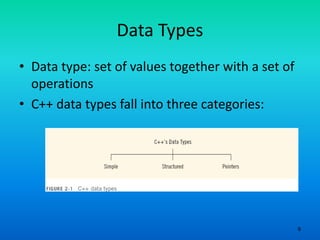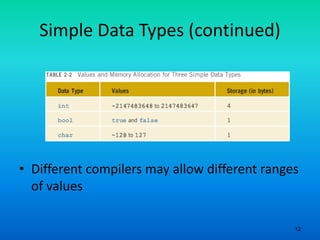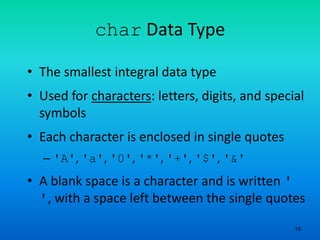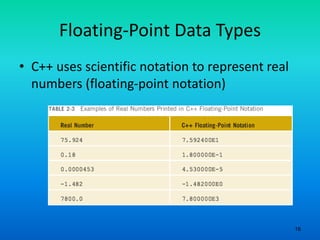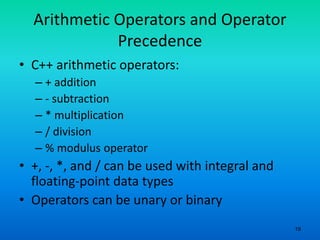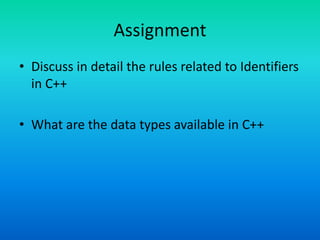Object oriented programming 8 basics of c++ programming
- 1. Object Oriented Programming: 8 Basics of C++ Programming Prof Neeraj Bhargava Vaibhav Khanna Department of Computer Science School of Engineering and Systems Sciences Maharshi Dayanand Saraswati University Ajmer
- 2. 2 The Basics of a C++ Program • Function: collection of statements; when executed, accomplishes something – May be predefined or standard • Syntax: rules that specify which statements (instructions) are legal • Programming language: a set of rules, symbols, and special words • Semantic rule: meaning of the instruction
- 3. 3 Comments • Comments are for the reader, not the compiler • Two types: – Single line // This is a C++ program. It prints the sentence: // Welcome to C++ Programming. – Multiple line /* You can include comments that can occupy several lines. */
- 4. 4 Special Symbols • Special symbols + - * / . ; ? , <= != == >=
- 5. 5 Reserved Words (Keywords) • Reserved words, keywords, or word symbols – Include: • int • float • double • char • const • void • return
- 6. 6 Identifiers • Consist of letters, digits, and the underscore character (_) • Must begin with a letter or underscore • C++ is case sensitive – NUMBER is not the same as number • Two predefined identifiers are cout and cin • Unlike reserved words, predefined identifiers may be redefined, but it is not a good idea
- 7. 7 Identifiers (continued) • The following are legal identifiers in C++: – first – conversion – payRate
- 8. 8 Whitespaces • Every C++ program contains whitespaces – Include blanks, tabs, and newline characters • Used to separate special symbols, reserved words, and identifiers • Proper utilization of whitespaces is important – Can be used to make the program readable
- 9. 9 Data Types • Data type: set of values together with a set of operations • C++ data types fall into three categories:
- 10. 10 Simple Data Types • Three categories of simple data – Integral: integers (numbers without a decimal) – Floating-point: decimal numbers – Enumeration type: user-defined data type
- 11. 11 Simple Data Types (continued) • Integral data types are further classified into nine categories:
- 12. 12 Simple Data Types (continued) • Different compilers may allow different ranges of values
- 13. 13 int Data Type • Examples: -6728 0 78 +763 • Positive integers do not need a + sign • No commas are used within an integer – Commas are used for separating items in a list
- 14. 14 bool Data Type • bool type – Two values: true and false – Manipulate logical (Boolean) expressions • true and false are called logical values • bool, true, and false are reserved words
- 15. 15 char Data Type • The smallest integral data type • Used for characters: letters, digits, and special symbols • Each character is enclosed in single quotes – 'A', 'a', '0', '*', '+', '$', '&' • A blank space is a character and is written ' ', with a space left between the single quotes
- 16. 16 • C++ uses scientific notation to represent real numbers (floating-point notation) Floating-Point Data Types
- 17. 17 Floating-Point Data Types (continued) – float: represents any real number • Range: -3.4E+38 to 3.4E+38 (four bytes) – double: represents any real number • Range: -1.7E+308 to 1.7E+308 (eight bytes) – On most newer compilers, data types double and long double are same
- 18. 18 Floating-Point Data Types (continued) • Maximum number of significant digits (decimal places) for float values is 6 or 7 • Maximum number of significant digits for double is 15 • Precision: maximum number of significant digits – Float values are called single precision – Double values are called double precision
- 19. 19 Arithmetic Operators and Operator Precedence • C++ arithmetic operators: – + addition – - subtraction – * multiplication – / division – % modulus operator • +, -, *, and / can be used with integral and floating-point data types • Operators can be unary or binary
- 20. 20 Order of Precedence • All operations inside of () are evaluated first • *, /, and % are at the same level of precedence and are evaluated next • + and – have the same level of precedence and are evaluated last • When operators are on the same level – Performed from left to right (associativity) • 3 * 7 - 6 + 2 * 5 / 4 + 6 means (((3 * 7) – 6) + ((2 * 5) / 4 )) + 6
- 21. Assignment • Discuss in detail the rules related to Identifiers in C++ • What are the data types available in C++








